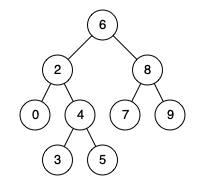235. Lowest Common Ancestor of a Binary Search Tree (E)
Given a binary search tree (BST), find the lowest common ancestor (LCA) of two given nodes in the BST.
According to the definition of LCA on Wikipedia: “The lowest common ancestor is defined between two nodes p and q as the lowest node in T that has both p and q as descendants (where we allow a node to be a descendant of itself).”
Example 1:

Input: root = [6,2,8,0,4,7,9,null,null,3,5], p = 2, q = 8
Output: 6
Explanation: The LCA of nodes 2 and 8 is 6.Example 2:

Input: root = [6,2,8,0,4,7,9,null,null,3,5], p = 2, q = 4
Output: 2
Explanation: The LCA of nodes 2 and 4 is 2, since a node can be a descendant of itself according to the LCA definition.Example 3:
Input: root = [2,1], p = 2, q = 1
Output: 2
Constraints:
The number of nodes in the tree is in the range
[2, 105].-109 <= Node.val <= 109All
Node.valare unique.p != qpandqwill exist in the BST.
Solution:
https://www.jiuzhang.com/solution/lowest-common-ancestor-of-a-binary-search-tree/
解题思路
这道题与88. 最近公共祖先相似,都是求树内两个节点的最近公共祖先(LCA),我们本题也继续采用深度优先搜索(DFS)的方法。
不同的是,这道题明确指出这是二叉搜索树(BST),我们复习一下BST的性质:
对任意节点N,左子树上的所有节点的值都小于等于节点N的值
对任意节点N,右子树上的所有节点的值都大于等于节点N的值
BST的左子树和右子树也都是 BST
我们如果在搜索时充分利用BST的性质,就能够有效剪枝。
算法流程
从根节点
root开始,遍历整棵树如果
root等于p或q,那么root即为p和q的LCA。如果
root同时大于p和q,说明p和q都在左子树上,那么将root.left作为根节点,继续第一步的操作。如果
root同时小于p和q,说明p和q都在右子树上,那么将root.right作为根节点,继续第一步的操作。如果以上情况都不成立,说明
p和q分别在两颗子树上,那么root就是p和q的LCA。
复杂度分析
时间复杂度:O(N),其中 N 为 BST 中节点的个数。在最坏的情况下,BST退化成链表,我们可能访问 BST 中所有的节点。
空间复杂度:O(N),其中 N 为 BST 中节点的个数。所需开辟的额外空间主要是递归栈产生的,在最坏的情况下,BST退化成链表,那么递归栈的深度就是BST的节点数目。
Last updated
Was this helpful?